It is estimated that by 2050, human population numbers will have risen from today’s 7.6bn to 9.8bn.
With more mouths to feed, and depleting land and freshwater sources, we are experiencing a ‘food emergency’, Dr Antonella Leone from Italy’s CNR Institute of Sciences for Food Production told FoodNavigator.
At the same time, fisheries are increasingly over-exploited, leading to reduced fish supplies. Jellyfish populations, however, are on the rise, said Dr Leone. “It is important we diversify our food sources and investigate raw materials with a lower environmental impact.”
Research funded by the European Commission, under its Horizon 2020 programme, is working to do just that. The ‘GoJelly’ food study, which launched in 2018 and is due for completion in 2021, is looking at the potential of jellyfish varieties as novel foods to help diversify nutrition sources for the future.
Health benefits of east meets west
While regarded a ‘novel food’ in Europe, jellyfish have been eating by humans for millennia. Regarded a delicacy in some Asian cultures, certain species of edible jellyfish offer a range of nutritional benefits.
“Different classes of compounds are present in jellyfish,” explained Dr Leone, who is heading up this task in the EU-funded study. The tentacled sea creature’s primary compound, collagen, is a protein that aids antioxidant and anti-inflammatory activity.
“When digested, collagen produces several small peptides [that can provide] anti-arthritic properties,” she continued. “We are studying the effects of this small peptide on human cells to establish the real activity of proteins from jellyfish.”
Further, many jellyfish species host microalgaes that are ‘very rich’ in pigments and compounds – such as omega-3 and omega-6 – that aid antioxidant activity, we were told. “While we get very little protein from jellyfish, because most of the weight is water, the small amount we do get is active. These nutrients could prove very healthy for humans.”
Mediterranean jellyfish diet
The study is looking at a number of Mediterranean jellyfish varieties for food, including the barrel jellyfish Rhizostoma pulmo, which is found in Italy’s Ionian Sea. “We are focusing on the Rhizostoma pulmo because it is very similar to other Asiatic species,” said Dr Leone, citing the species’ large size (approx. 50cm in diameter) and compact texture.
The Aurelia coerulea jellyfish has also being investigated, but the lead researcher told us its small size and fragile composition means it is “not useful for food”.
Cotylorhiza tuberculate is another interesting species, she continued. “It contains microalgae, which lives within the jellyfish in symbiosis. When you use the jellyfish you can use all the compounds present in the microalgae, including lipids containing omega-3 and omega-6 fatty acids.”

While jellyfish cultivation is ‘not yet possible’, certain coastal countries in Asia manage to increase jellyfish populations by rearing polyps and ephyrae – or larval jellyfish –in aquariums, Dr Leone explained.
“When they are a bit bigger, they are put out again to sea. This enriches the sea with newborn jellyfish. It is not quite cultivation, but it increases the amount of edible species.”
In Western countries, there are no such cultivation programmes in place. “This is one of the goals of future projects,” Dr Leone continued.
How to eat jellyfish?
All parts of an edible jellyfish can be consumed, including the umbrella – which is favoured in Asia – and the oral arms, located near its mouth. Indeed, the oral arms contain greater antioxidant properties, we were told.
In terms of its taste profile, jellyfish is ‘very similar’ to oysters, said Dr Leone. Similar to its mollusc counterpart, jellyfish ‘smell of the sea’ and are ‘very salty’.
To date, however, jellyfish have been largely dried using potentially ‘toxic’ substances, she continued. In China, the traditional dehydrating process uses alum and salt. “But the alum is very toxic and related to many diseases, so it is important to eliminate the alum from the processing.”
Dr Leone’s team is working on a patent to eliminate alum from the drying process, which could enable jellyfish to be used as both an ingredient and a finished food product. A company based in Ostuni, Puglia, which specialises in vegetable drying, is now working with Dr Leone’s team to scale up this process.
Research has also revealed that boiling Rhizostoma pulmo in water preserves its antioxidant content, she added.
Hurdles to market
Before these soft bodied invertebrates end up on our plate, however, they will be required to undergo safety and quality testing under EU Novel Food regulation.
“When our studies, or the studies of other colleagues, demonstrate the safety and quality of the jellyfish product, it could make for a very interesting new food – that could be consumed not only in Europe, but also in other Western countries that don’t have the tradition of consuming jellyfish, but which have many jellyfish in their seas,” said Dr Leone.
While eating jellyfish is not commonplace in the Western world, the researcher suggested uptake could be greater than that of other novel food sources in Europe.
“When educated about new food products, consumers are usually open [to trying them]. In Italy, for example, sushi is becoming very common, [yet] it is not a traditional Italian food. Jellyfish could have a similar effect.”
Dr Leone suggested that jellyfish may well have the potential to be better received than insects – which are touted as nutritious and sustainable alternatives to conventional protein. “[In consumers’ minds] insects are linked to unsafe, dirty food.
“My impression is that jellyfish would be better accepted by Western countries’ audiences.”


